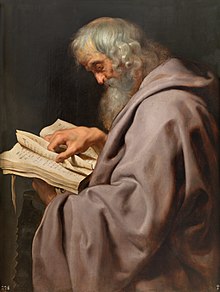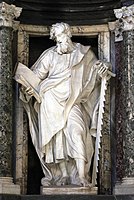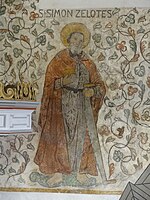Simon the Zealot
Simon the Zealot | |
|---|---|
 | |
| Apostle, Preacher, Martyr | |
| Born | 1st century AD Cana,Galilee,Judaea,Roman Empire |
| Died | ~65[1] Province of Britain,Roman Empire |
| Venerated in | AllChristian denominationsthat venerate saints |
| Majorshrine | relics claimed by many places, includingToulouse;Saint Peter's Basilica[2] |
| Feast | October 28 (Western Christianity) May 10 (Byzantine Christianity) Pashons 15(Coptic Christianity) ግንቦት 15 (Ethiopian Christianity) July 1 (medieval Hispanic liturgy as attested by sources of the time, such as the Antiphonary of León) |
| Attributes | boat; cross and saw; fish (or two fish); lance;man being sawnin two longitudinally; oar[2] |
| Patronage | curriers;sawyers; tanners[2] |
Simon the Zealot(Acts 1:13,Luke 6:15) orSimon the CanaaniteorSimon the Canaanean(Matthew 10:4,Mark 3:18;Greek:Σίμων ὁ Κανανίτης;Coptic:ⲥⲓⲙⲱⲛ ⲡⲓ-ⲕⲁⲛⲁⲛⲉⲟⲥ;Classical Syriac:ܫܡܥܘܢ ܩܢܢܝܐ)[3]was one of the most obscure among theapostles of Jesus.A fewpseudepigraphicalwritings were connected to him, butJeromedoes not include him inDe viris illustribuswritten between 392 and 393 AD.[4]
Identity[edit]

The nameSimonoccurs in all of theSynoptic Gospelsand theBook of Actseach time there is a list of apostles, without further details:
Simon, (whom he also named Peter,) and Andrew his brother, James and John, Philip and Bartholomew, Matthew and Thomas, James the son of Alphaeus, and Simon called Zelotes, And Judas the brother of James, and Judas Iscariot, which also was the traitor.
The Zealot[edit]
To distinguish him fromSimon Peter,he is given a surname in all three of theSynoptic Gospelswhere he is mentioned. Simon is called "Zelotes"in Luke and Acts (Luke 6:15Acts 1:13). For this reason, it is generally assumed that Simon was a former member of the political party, theZealots.In Matthew and Mark, however, he is called "Kananites"in theByzantine majorityand "Kananaios"in theAlexandrian manuscriptsand theTextus Receptus(Matthew 10:4Mark 3:18). BothKananaiosandKananitesderive from theHebrewwordקנאיqanai,meaningzealous,so most scholars today generally translate the two words to mean "Zealot". However,Jeromeand others, such asBede,suggested that the word "Kananaios" or "Kananite" should be translated as "Canaanean" or "Canaanite", meaning that Simon was from the town of קנהCanainGalilee.[5]If this is the case, hisepithetwould have been "Kanaios".
Robert Eisenmanhas argued that contemporarytalmudicreferences to Zealots refer to them askanna'im"but not really as a group—rather as avenging priests in the Temple".[6]Eisenman's broader conclusions, that the zealot element in the original apostle group was disguised and overwritten to make it support the assimilativePauline Christianityof theGentiles,are more controversial.John P. Meierargues that the term "Zealot" is a mistranslation and in the context of the Gospels means "zealous" or "religious" (in this case, for keeping the Law of Moses), as the Zealot movement apparently did not exist until 30 to 40 years after the events of the Gospels.[7]However, neitherBrandon[8]norHengel[9]support this view.
Other identifications[edit]
In the gospels Simon the Zealot is not directly identified withSimon the brother of Jesusmentioned inMark 6:3:
Is not this the carpenter, the son of Mary and brother of James and Joses and Judas and Simon, and are not his sisters here with us? "And they took offense at him.
TheCatholic Encyclopediasuggests that Simon the Zealot may be the same person asSimeon of JerusalemorSimon the brother of Jesusor both. He would then be the cousin of Jesus or a son of Joseph from a previous marriage.[10]Another tradition holds that this is the Simeon of Jerusalem who became the second bishop of Jerusalem, although he was born in Galilee.[11][12]
-
James Tissot,Saint Simon,Brooklyn Museum
-
Statue of Saint Simon in theArchbasilica of Saint John Lateranby Francesco Moratti.
-
The Apostle Simon the ZealotbyGeorg Gsell
-
Simon Zelotes evangelische Kirche Leihgestern
-
Statue of Simon the Zealot byHermann Schievelbeinat the roof of theHelsinki Cathedral
Later tradition[edit]



Isidore of Sevilledrew together the accumulated anecdotes of Simon inDe Vita et Morte.
According tothe Golden Legend,which is a collection ofhagiographies,compiled byJacobus de Voraginein the thirteenth century "Simon the Cananaean andJudas Thaddeuswere brethren ofJames the Lessand sons ofMary Cleophas,who was married to Alpheus. "[13][14]
In the apocryphalArabic Infancy Gospela fact related to this apostle is mentioned. A boy named Simon is bitten by a snake in his hand; he is healed by Jesus, who told the child "you shall be my disciple". The mention ends with the phrase "this is Simon the Cananite, of whom mention is made in the Gospel."[15]
In later tradition, Simon is often associated withJude the Apostleas an evangelizing team; in Western Christianity, they share theirfeast dayon 28 October. The most widespread tradition is that after evangelizing inEgypt,Simon joined Jude inPersiaandArmeniaorBeirut,Lebanon,where both were martyred in 65 AD. This version is the one found in theGolden Legend.He may have suffered crucifixion as the Bishop of Jerusalem. According to an Eastern tradition Simon travelled to Georgia on a missionary trip, died in Abkhazia and was buried in Nicopsia. His remains were later transferred toAnakopia.[16]
Another tradition states that he traveled in theMiddle EastandAfrica.ChristianEthiopiansclaim that he was crucified inSamaria,whileJustus Lipsiuswrites that he wassawn in halfatSuanir,Persia.[14]However,Moses of Chorenewrites that he was martyred at Weriosphora inCaucasian Iberia.[14]Tradition also claims he died peacefully atEdessa.[17][18]
Yet another tradition says he visitedRoman Britain.In this account, in his second mission to Britain, he arrived during the first year ofBoadicea's rebellion (60 AD). He was crucified 10 May 61 AD by the Roman Catus Decianus, atCaistor,modern-dayLincolnshire,Britain.[19]According toCaesar BaroniusandHippolytus of Rome,Simon's first arrival in Britain was in the year A.D. 44, during theRoman conquest.[19]Nikephoros I of Constantinoplewrites:[19][20]
Simon born in Cana of Galilee who for his fervent affection for his Master and great zeal that he showed by all means to the Gospel, was surnamed Zelotes, having received the Holy Ghost from above, travelled through Egypt, and Africa, then through Mauretania and all Libya, preaching the Gospel. And the same doctrine he taught to the Occidental Sea, and the Isles called Britanniae.
Another tradition, doubtless inspired by his title "theZealot",states that he was involved in theFirst Jewish–Roman War(66–73 AD).[8][9]
The second centuryEpistle of the Apostles(Epistula Apostolorum),[21]a polemic againstgnostics,lists him among the apostles purported to be writing the letter (who include Thomas) as Judas Zelotes. CertainOld Latin translationsof theGospel of Matthewsubstitute "Judas the Zealot" forThaddeus/Lebbaeusin Matthew 10:3. To some readers, this suggests that he may be identical with the "Judas not Iscariot" mentioned inJohn 14:22:"Judas saith unto him, not Iscariot, Our Lord, how is it that thou wilt manifest thyself unto us, and not unto the world?" As it has been suggested that Jude is identical with theApostle Thomas(seeJude Thomas), an identification of "Simon Zelotes" with Thomas is also possible.Barbara Thieringidentified Simon Zelotes withSimon Magus;however, this view has received no serious acceptance. TheNew Testamentrecords nothing more of Simon, aside from this multitude of possible but unlikely pseudonyms. He is buried in the same tomb asJude Thaddeus,in the left transept of the St. Peter's Basilica in Rome, under the altar of Saint Joseph.
In Islam, Muslim exegesis and Quran commentary name the twelve apostles and include Simon amongst the disciples.Muslim traditionsays that Simon was sent to preach the faith ofGodto theBerbers,outsideNorth Africa.[22]
In art, Simon has the identifying attribute of asawbecause according to tradition he was martyred bybeing sawn in half.[11]
Sainthood[edit]
Simon, like the other Apostles, is regarded as a saint by theCatholic Church,including theEastern Catholic Churches,as also by theEastern Orthodox Churches,theOriental Orthodox Churches,Lutheran Churchand the churches of theAnglican Communion.In theChurch of Englandhe isremembered(withJude) with aFestivalon28 October.[23]
References[edit]
- ^"St. Simon the Apostle"(in Italian). Blessed Saints and Witnesses. 2005-03-15.Retrieved29 March2010.
- ^abcJones, Terry H (6 January 2009)."Saint Simon the Apostle".Saints.SQPN.com.Retrieved29 March2010.
- ^"Saint Simon".st-takla.org(in Arabic).
- ^Booth, A.D. (1981). "The Chronology of Jerome's Early Years".Phoenix.35(3). Classical Association of Canada: 241.doi:10.2307/1087656.JSTOR1087656.
This work [De viris illustribus], as he reveals at its start and finish, was completed in the fourteenth year of Theodosius, that is, between 19 January 392 and 18 January 393.
- ^"Archived copy".Archived fromthe originalon 2023-04-01.Retrieved2023-05-20.
{{cite web}}:CS1 maint: archived copy as title (link) - ^Eisenman, Robert(1997).James the Brother of Jesus: The Key to Unlocking the Secrets of Early Christianity and the Dead Sea Scrolls.Viking Penguin. pp. 33–34.
- ^Meier, John(2001).A Marginal Jew: Rethinking the Historical Jesus Volume 3: Companions and Competitors.Yale University. pp. 132–135.ISBN978-0-300-14032-3.
- ^abBrandon, S.G.F. (1967).Jesus and the Zealots: A Study of the Political Factor in Primitive Christianity.Manchester University Press.
- ^abHengel, M. (1989).The Zealots: Investigations into the Jewish Freedom Movement in the Period from Herod I Until 70 A.D.Translated by Dr David Smith. Edinburgh: T. & T. Clark.ISBN978-0-567-29372-5.
- ^Bechtel, Florentine Stanislaus (1907)..In Herbermann, Charles (ed.).Catholic Encyclopedia.Vol. 2. New York: Robert Appleton Company.
- ^abLöffler, Klemens (1912)..In Herbermann, Charles (ed.).Catholic Encyclopedia.Vol. 13. New York: Robert Appleton Company.
- ^Appendix to the Works of Hippolytus 49.11
- ^de Voragine, Jacobus (1275).The Golden Legend or Lives Of The Saints.Retrieved28 October2018.
- ^abcStracke, Richard.Golden Legend: Life of SS. Simon and Jude.Retrieved28 October2018.
- ^The Arabic Gospel of the Infancy of the Saviour.
- ^McDowell, Sean (2016).The Fate of the Apostles: Examining the Martyrdom Accounts of the Closest Followers of Jesus.Routledge. p. 247.ISBN9781317031895.
- ^"St. Simon of Zealot".Catholic Online.Retrieved29 March2010.
- ^"St. Jude Thaddeus and St. Simon the Zealot, Apostles".Catholic News Agency.Catholic News Agency.Retrieved29 July2021.
- ^abcJowett, G.F. (1961).The Drama of the Lost Disciples.Covenant Publishing Company. p. 159.ISBN978-0-85205-008-8.
- ^Cornelius a Lapide, Argumentus Epistoloe St. Pauli di Romanos, ch. 16.
- ^"Epistula Apostolorum".Early Christian Writings.Retrieved29 March2010.
- ^Noegel, Scott B.; Wheeler, Brandon M. (2003).Historical Dictionary of Prophets in Islam and Judaism.Lanham, MD: Scarecrow Press (Rowman & Littlefield). p. 86.ISBN978-0810843059.
Muslim exegesis identifies the disciples of Jesus as Peter, Andrew, Matthew, Thomas, Philip, John, James, Bartholomew, and Simon
- ^"The Calendar".The Church of England.Retrieved2021-03-27.
External links[edit]
- All appearances of "Simon" in the New Testament(mostly referring to Simon Peter)
- Legenda Aurea:Lives of Saints Simon and Jude
- "St. Simon the Apostle"in theCatholic Encyclopedia
- "Ὁ Ἅγιος Σίμων ὁ Ἀπόστολος ὁ Ζηλωτής".Megas Synaxaristis(in Greek).







